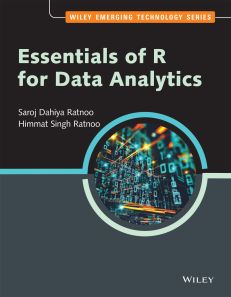Essentials of R for Data Analytics
ISBN: 9789390421923
332 pages
For more information write to us at: acadmktg@wiley.com

Description
With widespread and exponential growth of data, people with data science background are in great demand. Data analytics, a subdomain of data science, is meant to turn data into insight and actionable knowledge. Data analytics mainly deals with exploring, visualizing, transforming and modelling data for making predictions. Learning R is an essential step towards becoming a data analyst.
Preface
Acknowledgments
About the Authors
Chapter 1 Introduction to HR Analytics
1.1 Introduction
1.2 About the R Environment
1.3 Starting R and RStudio
1.4 Entering and Executing Commands
1.5 Setting Variables
1.6 Knowing about Objects
1.7 Structure of Objects
1.8 Managing Objects in R’s Workspace
1.9 Creating Sequences
1.10 Operator Precedence
1.11 Setting Working Directory
1.12 Making and Executing Code from Script Files
1.13 Packages in R
Chapter 2 Getting Help in R
2.1 Introduction
2.2 Top-Level Help
2.3 Help On Functions
2.4 Searching Documentation Through Keywords
2.5 Getting Help from Web
2.6 Searching for Relevant Packages
2.7 Getting Help from R Mailing Lists
Chapter 3 Vectors and Factors in R
3.1 Introduction
3.2 Vectors
3.3 Factors
Chapter 4 Matrices in R
4.1 Introduction
4.2 Arrays
4.3 Creating Matrices
4.4 Naming the Dimensions of a Matrix
4.5 Accessing Elements of Matrices
4.6 Arithmetic Operations on Matrices
4.7 Concatenating Matrices
4.8 Replicating Matrices
4.9 Other Useful Operations on Matrices
Chapter 5 Lists and Data Frames in R
5.1 Introduction
5.2 Lists in R
5.3 Data Frames in R
Chapter 6 Strings and Dates in R
6.1 Introduction
6.2 Handling Strings
6.3 Handling Date and Time
Chapter 7 Input Output in R
7.1 Introduction
7.2 Reading Data from Console
7.3 Reading Data from Files
7.4 Displaying Data to Screen
7.5 Saving Objects to Files
7.6 Writing Data to Files
Chapter 8 Conditional Statements and Loops in R
8.1 Introduction
8.2 Control Structures for Conditional Execution
8.3 Looping Structures in R
Chapter 9 Writing Functions in R
9.1 Introduction
9.2 Functions in R
9.3 Defining a Function
9.4 Anonymous Functions
9.5 Scope of objects
9.6 Return Value of a Function
9.7 Named and Default Arguments
9.8 Passing Arguments to a Function
9.9 The … Arguments
9.10 Modifying a Data Frame Using a Function
9.11 Defining New Binary Operators
Chapter 10 An Introduction to Graphics in R
10.1 Introduction
10.2 Pressure Dataset
10.3 Iris Dataset
10.4 My First Plot
10.5 Adding Elements
10.6 Controlling the Type of Scatter Plot
10.7 Controlling the Types of Lines and Points
10.8 Adding Grids
10.9 Customizing Axes
10.10 Scatter Plot with Groups in Data
10.11 Adding Legend
10.12 Adding a Regression Line
10.13 Creating Separate Scatter Plot for Each Factor Level
10.14 Customizing Margins
10.15 Adding Text
10.16 Saving Your Plot
10.17 Working with Multiple Graphics Devices
10.18 Plotting Scatter Plot of all Variables in a Dataset
10.19 Combining Multiple Plots in a Graphics Window
10.20 Graphics Parameters
10.21 A Customized Colourful Plot
Chapter 11 Making Graphs and Charts in R
11.1 Introduction
11.2 Frequency Distribution of Categorical Data: Making Bar Charts
11.3 Frequency Distributions of Continuous Data: Making Histograms
11.4 Five-Number Summary: Making Box Plots
11.5 Visualizing Relationships in Continuous Data: Scatter Plot and Line Charts
11.6 Plotting Functions
11.7 Confirming Data Distribution: Making Q–Q Plots
11.8 Other Plots and Charts
11.9 Contour Plots
Chapter 12 Graphics using ggplot2
12.1 Introduction
12.2 Scatter Plots
12.3 Geometric Objects in ggplot2: Creating Different Plots
12.4 Overall Appearance of a Plot
12.5 Other Resources and References
Chapter 13 Data Transformations in R
13.1 Introduction
13.2 Datasets
13.3 Transformation Functions in “dplyr”
13.4 Data Transformation in Action on iris Dataset
13.5 Answering Questions on flights Dataset
Chapter 14 Predictive Analytics: Classification in R
14.1 Introduction
14.2 Classification
14.3 Some Popular Classification Models
14.4 Implementing Classification in R
Chapter 15 Predictive Analytics: Regression in R
15.1 Introduction
15.2 Simple Linear Regression Model
15.3 Determination of β0 and β1
15.4 Multiple Linear Regression
15.5 Predictive Modelling Using Regression
15.6 Simple Linear Regression Predictive Modelling in R
15.7 Modelling with Multiple Linear Regression in R
15.8 Regression Modelling with Higher Order Ploynomial Terms
15.9 Regression Modelling with Interaction Term
Appendix
Additional Resources
Index

